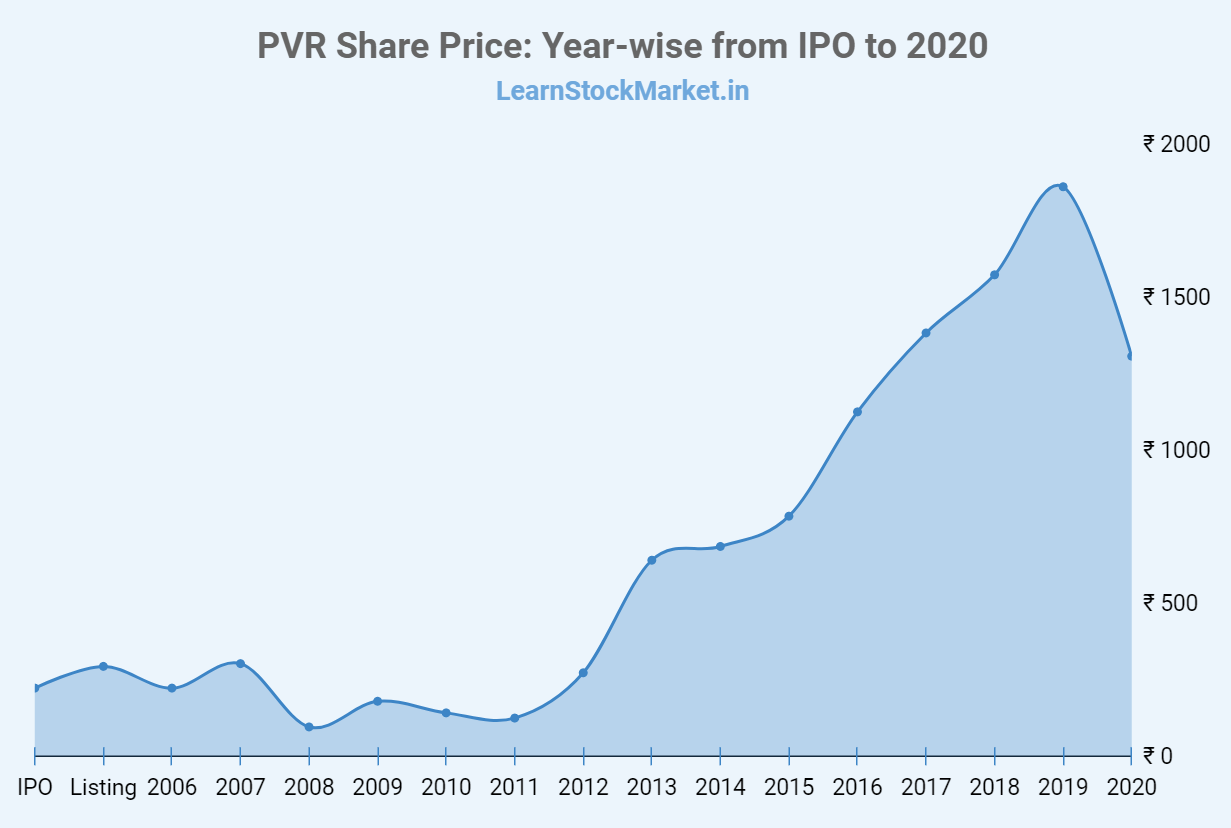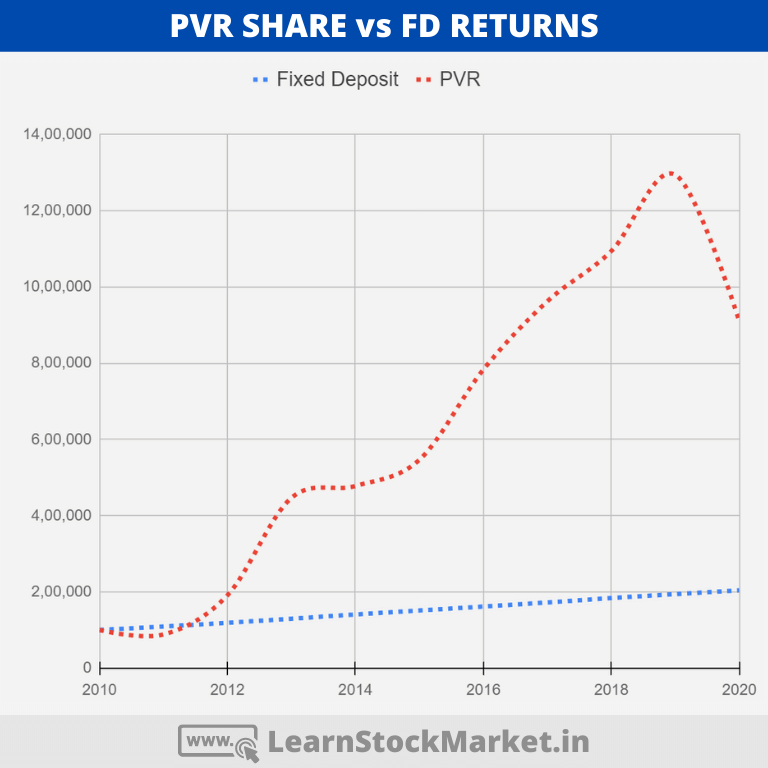PVR is the largest multiplex chain in India, with 800 screens spread across 170 locations all over the country.
The company has been ripped-apart due to the Covid19 pandemic. Cinemas across the country were shut for more than 7 months.
The losses the company has incurred over just 3 quarters (9 months) is more than the profits it made over 4 years between 2016 to 2019.
To survive, PVR has raised more capital. Their borrowings have crossed the 4000 crore mark. The future remains uncertain as people aren’t yet coming back to cinema halls – the biggest reason for this is the lack of major movie releases.
The PVR Share Price crashed from a high of nearly ₹ 2100 per share in February 2020, to a low of ₹ 705 per share during the lockdown in May 2020.
With market sentiments turning positive over the last 9 months, the share price has rebounded to ₹ 1310 at the end of November 2020.
But at the moment, for PVR and its shareholders, there are more questions than answers.
- Will people return to theatres before the Covid vaccine is out?
- Will major production houses release their big-budget films during uncertain times? After all, a big-budget film is able to recover its costs only when more than 1.5 crore people watch the film in theatres. Will so many people come to theatres?
- The other concern is – people are now used to watching films on ‘Over-The-Top’ (OTT) platforms. Has this done permanent damage to the experience of watching a film in theatre?
There is hope though.
A few regional films have released in theatres and have done reasonably well. There is also hope that people will come out to watch films in bigger numbers – a ‘family outing’ for most Indians is either a meal at a restaurant or movie in a theatre.
The experience of watching a film on the big screen cannot possibly be replaced by content on the mobile phone.
If cinemas revive, PVR will be the biggest beneficiary as it’s the largest multiplex chain in the country. Many smaller single-screen theatres have already shut down and the big could get bigger once the scare of the Covid-pandemic is over.
Let’s get down to analyzing the PVR Share Price, its history and much more.
PVR Share Price History
The full form of PVR was Priya Village Roadshow, which was later changed to just ‘PVR’. It was the first company to introduce the concept of multiplexes in India, way back in 1997.
The Initial Public Offering (IPO) was issued on 8th December 2005, for a price of ₹ 225 per share. The company was listed at the stock exchange on 4th January 2006.
- IPO: 25,37,500 Shares at ₹ 225 per share.
- Face Value: ₹ 10 per share.
- Listing Date: 04 January 2006.
- Listing Day Open: 266 per share
- Listing Day Low: 260 per share
- Listing Day High: 310 per share
- Listing Day Close: 296 per share
Since then, the stock has given reasonably good returns – beating fixed deposit. Without the unexpected downfall during Covid, the returns would’ve been fantastic for shareholders.
| PVR | Share Price | Rise / Fall |
| IPO | 225 | |
| Listing | 296 | 31.56% |
| 2006 | 225 | -23.99% |
| 2007 | 305 | 35.56% |
| 2008 | 98 | -67.87% |
| 2009 | 182 | 85.71% |
| 2010 | 144 | -20.88% |
| 2011 | 127 | -11.81% |
| 2012 | 275 | 116.54% |
| 2013 | 643 | 133.82% |
| 2014 | 688 | 7.00% |
| 2015 | 787 | 14.39% |
| 2016 | 1128 | 43.33% |
| 2017 | 1386 | 22.87% |
| 2018 | 1576 | 13.71% |
| 2019 | 1864 | 18.27% |
| 2020 | 1310 | -29.72% |

That’s the year-end share prices of PVR. What are your thoughts? Analyse the chart and form your own thoughts before scrolling down to read more.
There are two things that really stand out. The first 5 years and the next 8 years.
The returns if you bought on listing day (January 2006), weren’t great for the first few years. In fact, PVR was listed when the stock markets around the world were going crazy.
To give you a comparison, Nifty was at 2800 when PVR was listed. It went to a high of 6200. PVR significantly underperformed during this period.
And then came the 2008 market crash and PVR crashed by nearly 70%.
Most investors would’ve lost hope here and exited the stock. Those who didn’t exit in fear in 2008, would’ve exited when the company remained below its IPO price till 2011.
Then came the boom.
From 2011 through to 2019 – PVR went from strength to strength. 2018 was the year when most small and mid caps crashed – but PVR remained rock-solid and gave excellent returns to investors.
Analysts were giving buy calls, film business was growing with ‘content-driven concept films’ doing well at the box office. A select few South Indian films were performing exceptionally well all over the country.
Ticket prices were increased during festive seasons for big movies, like a Salman Khan Eid release or a Shah Rukh Khan Diwali release. Pop corn and Pepsi was costing more than the ticket price itself and people were willing to pay.
Because as I mentioned in the beginning of the article, family outing for Indians is either movies or going to a restaurant.
It’s here when optimism was its peak, when things could not go wrong for PVR, that the unexpected happened.
The Novel Corona Virus.
The lockdown wrecked havoc the economy and one of the most affected sectors was theatre business. They had to pay rent, they had to pay salary – but their business was completely and indefinitely shut.
This is the reason why there is nothing called a ‘100% safe company’ or ‘totally safe investment’ in the stock market. The unexpected can happen.
A strict stop-loss even for a long term investment, always helps. Learning technical analysis also helps.
If you are unlucky to be invested in a company where disaster has struck – you have only two options. One, get out of it as soon as possible i.e. the first big sign of trouble.
Or two, if you believe in the business – you need to stick around and see the period through. This is exceptionally difficult and not for the weak-hearted. ‘Opportunity Cost’ would also need to be taken into consideration because the stock might not perform for 2-3-4 years.
But inspite of the extremely difficult situation the company and its investors find themselves in – PVR could still do exceptionally well in the years to come.
Check out these stats:
Average Cost of a Multiplex Ticket:
- United States – $ 10 or ₹ 750
- United Kingdom – $ 13.5 or ₹ 1000
- China – $ 12 or ₹ 900
- India – $ 3 or ₹ 225
Tickets in India are still cheap. Prices could increase in the days to come.
Average Number of ‘Film Screens’ per 1 Lakh population:
- United States – 14 screens
- United Kingdom – 6.8 screens
- China – 2.5 screens
- India – 0.9 screens.
There is huge potential to increase the number of screens across the country. PVR being the leader of the sector, could benefit the most.
This view is really long-term and there are so many factors involved. But money is made when its invested in businesses which are struggling. If they manage to survive the tough times, they end up getting bigger and stronger.
PVR Share Returns: Compounded and Absolute
How much returns has PVR given if you bought the share 2 years ago? Or 3, 4 or 5 years ago.
What if you were holding PVR shares from the time of its IPO? What if you bought shares on the listing day at ₹ 296 per share and managed to hold it through its ups and downs.
Check out the table below:
| Time Period | CAGR | Absolute |
| 2 years | -8.83% | 0.83 times |
| 3 years | -1.86% | 0.95 times |
| 4 years | 3.81% | 1.16 times |
| 5 years | 10.73% | 1.66 times |
| 10 years | 24.71% | 9.10 times |
| Since Listing | 10.42% | 4.43 times |
| Since IPO | 12.46% | 5.82 times |
CAGR is Compounded Annual Returns. You can read the article on our website on CAGR. Absolute is exactly how many times your investment has grown.
As you can see in the absolute column, if you invested in PVR 10 years ago, your money would’ve gone up 9.1 times.
PVR has compounded at a decent rate of 12.46% since the IPO. You’d have obviously made the most amount of money if you bought 10 years ago.
Inspite of the recent crash, the stock has still managed to give returns of 24.71% – which is extraordinary.
1 Lakh invested in PVR Share
If you had invested 1 lakh in PVR, how much returns would it give over different time periods?
The table below has the figures:
| Time Period | 1 Lakh Invested |
| 2 years | 83,122 |
| 3 years | 94,517 |
| 4 years | 1,16,135 |
| 5 years | 1,66,455 |
| 10 years | 9,09,722 |
| Since Listing | 4,42,568 |
| Since IPO | 5,82,222 |
PVR Share vs FD Returns
What if you opened a fixed deposit of 1 lakh and made another investment of 1 lakh in PVR Shares.
The results are below. The returns from PVR does not include income from dividends.
| Year | Fixed Deposit | PVR |
| 2010 | 1,00,000 | 1,00,000 |
| 2011 | 1,09,130 | 88,194 |
| 2012 | 1,18,821 | 1,90,972 |
| 2013 | 1,29,515 | 4,46,528 |
| 2014 | 1,40,692 | 4,77,778 |
| 2015 | 1,51,075 | 5,46,528 |
| 2016 | 1,61,469 | 7,83,333 |
| 2017 | 1,72,093 | 9,62,500 |
| 2018 | 1,83,710 | 10,94,444 |
| 2019 | 1,93,997 | 12,94,444 |
| 2020 | 2,04,027 | 9,09,722 |
| Returns | 7.39% | 24.71% |

Some points to be noted:
- FD returns are as expected. Your money would’ve doubled in 10 years. There is hardly any reason to worry, as your investment is 100% safe – if you deposit it in a reliable bank.
- Investing in PVR shares – like any other listed stock – is filled with ups and downs.
- Notice how the investment loses value immediately after 1 lakh was invested in PVR.
- For nearly 1.5 years, returns were lower than fixed deposit. When reading this, 1.5 years might seem like a small period of time – but in the stock market, when the share price goes below investment value – 1.5 years can seem like several years.
- What if the stock falls further? Is one question that haunts many beginners.
- For those who held on, PVR gave phenomenal returns between 2012 to 2019. The returns were significantly higher than fixed deposit.
- 1 lakh investment became 14 lakhs – most investors won’t be able to hold shares when the value rises so many times. The few investors who did, might also quit due to the troubles the company is facing currently.
Bookmark this page and visit it at the end of the year 2021. It’ll be interesting to track the journey of the company. Will it survive the current crisis? Where will the share price be in 2021 and 2022?
Keep following for updates.


Thanks for writing this, it was very useful and helped me quite a bit